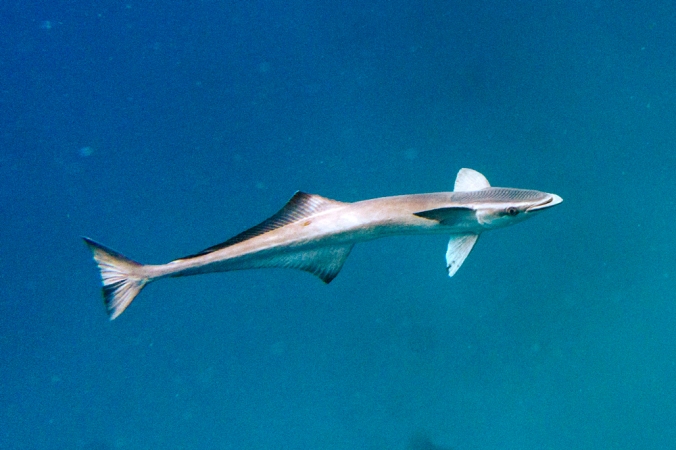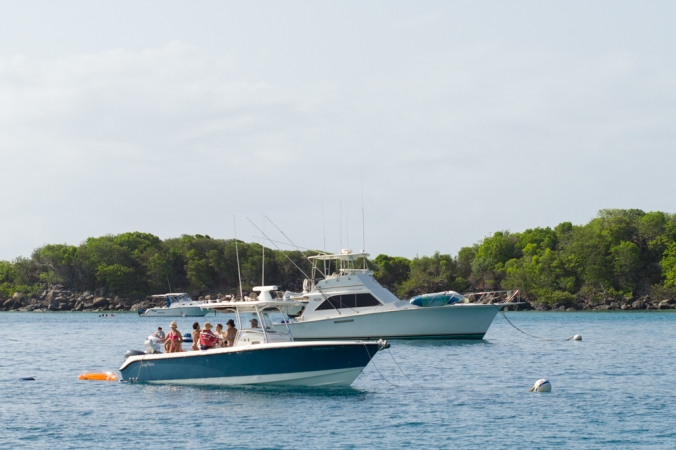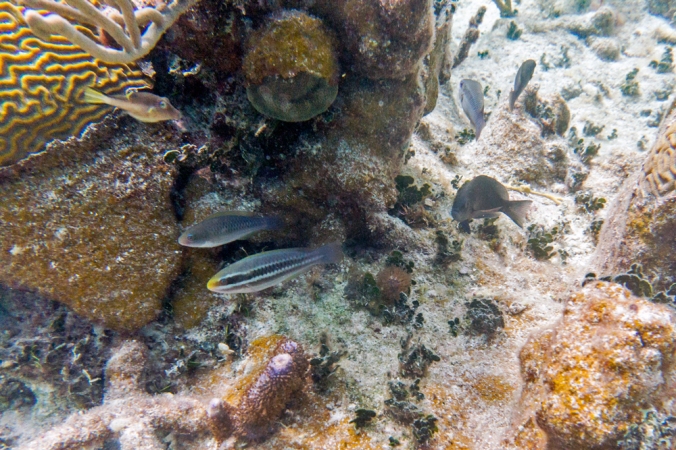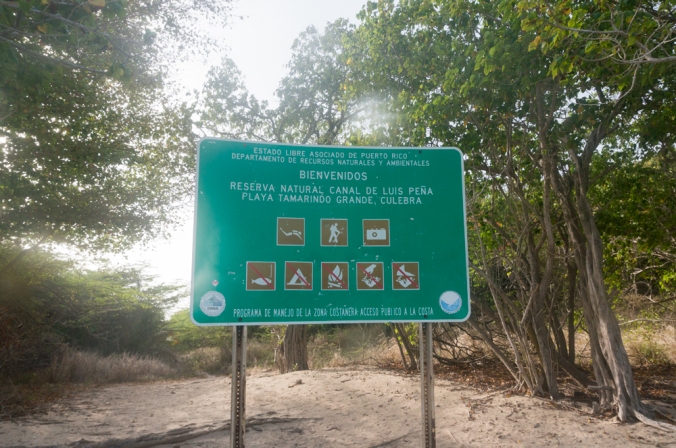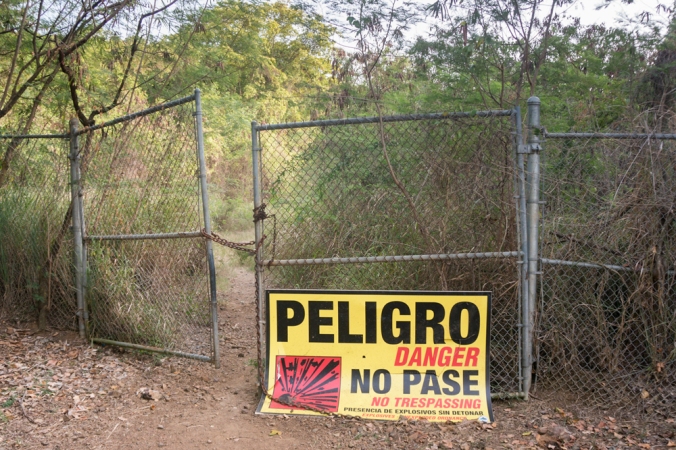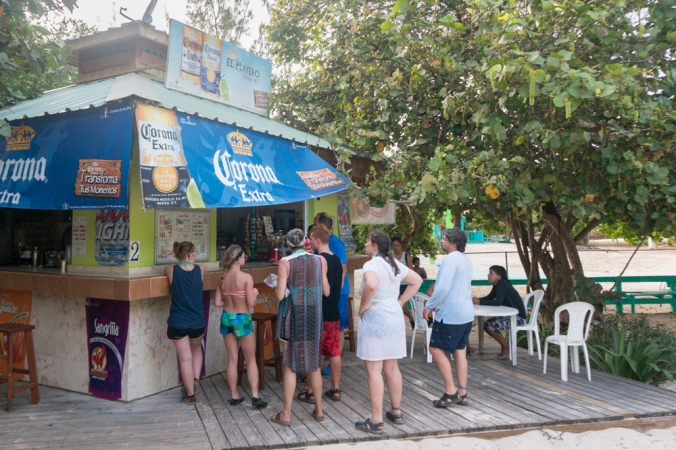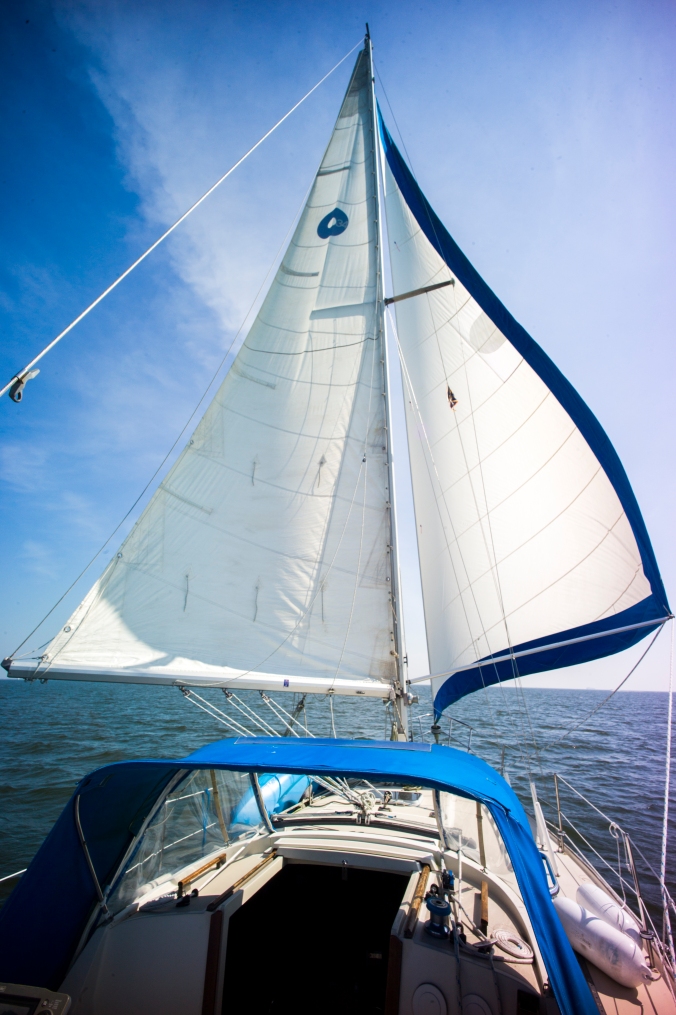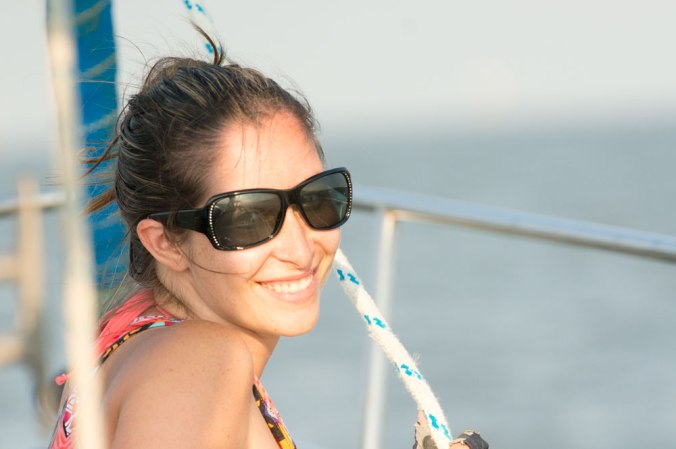One of my goals this trip was to catch the perfect tropical sunrise — except I snored right through it Friday morning in Bahia de Almodovar. However, when I finally got up and made some coffee, the view still wasn’t bad.

My first task of the morning was to shake out my camera bag to see if I had any other spare SD cards on hand. I lucked out and found an old 4GB card in one of the pockets, so I had both cameras back in use for at least a day.
The next task on my list was to pull up the cabin sole in the starboard ama to find the air-conditioner raw water strainer. After a few minutes of searching I located it under the floor of the front cabin and opened it up. I’d never seen a basket that full of seaweed.
I dumped it all overboard and gave the basket a rinse, then put it back together. The HI PS code cleared, and we had air-conditioning on the starboard side again.
We’d been getting low on fresh water and had considered buying some in Esperanza, but it was decided to just conserve until we stopped in Dewey. That meant no more showers, so Mary set the standard for cleanliness with her patented floating noodle hair washing method.

I noticed while snorkeling that morning that the starfish, which had been scattered all over the sandy bottom of the bay the night before, had disappeared. No idea where they went. I had no idea starfish moved around that much. Someone suggested that maybe they buried themselves in the sand, but I didn’t know they did that either.
Mid-morning we finally fired up the diesels and made the short motor across to Culebrita. Both catamarans had no trouble negotiating the mouth of Tortuga Bay, but the crew on the Jenneau didn’t like the way the cross current was pushing them around, so they turned back and picked up a mooring ball on the west side of the island.

Tortuga Bay was beautiful. The turquoise water lapped up against a white sand beach while a mix of charter vessels, cruising sailboats, and local motorboats bobbed around on moorings or at anchor beneath the ancient lighthouse up on the hill.


It was only a matter of minutes before the first green sea turtle was spotted swimming past Caicu, so we all hopped in the water to say, hello.

We encountered at least four different green sea turtles (it’s kind of hard to tell them apart) while in Tortuga Bay, as well as two different sting rays shuffling about on the sandy bottom.

I probably snorkeled with the sting rays a bit too long because when I got back to the boat I saw that everyone had already gone to shore to make the hike up to the lighthouse. At first I thought, no big deal, I was planning to swim in anyway. Then I realized that they had also taken my dry bag to get their shoes ashore for the hike. And yes, I offered the use of my dry bag — but my shoes, my camera, my shirt, and my water bottle that I had been planning to take in the dry bag were all still sitting in my cabin.
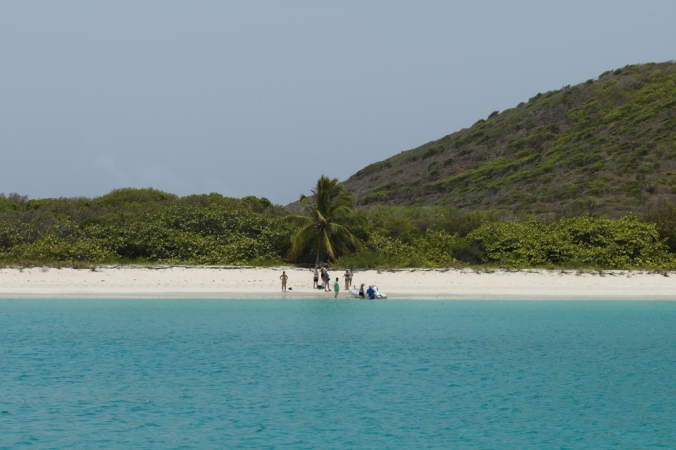
I sucked it up and swam to shore doing the sidestroke with my dive camera dangling from my wrist while holding my shoes up out of the water. That was a much longer swim than I had expected, but I did make it to shore with dry shoes. Plus, I got to guilt trip Mary about taking my bag and leaving me stranded for the rest of the trip, so it was worth it.

Culebrita has several trails and beaches to explore, but you definitely need shoes to hike them. The brush is prickly and there’s no shortage of cacti.

Small lizards were running everywhere through the brush and we stumbled across a family of goats on our way to the lighthouse. We also saw what looked like deer droppings, but we never saw any actual deer.
The path up to the Culebrita lighthouse presents a couple nice views of the harbors on the north and west sides of the island. We could see where Chateau du Mer finally picked up a mooring ball as well as our own boats back in Tortuga Bay.


Construction of the lighthouse began in 1882 and it was first lit in 1886. It was one of the oldest operating lighthouses in the US until it was closed in 1975. Currently, the lighthouse is in need of some serious restoration.

Many of the walls have collapsed, as have the spiral stairs leading up the tower. The area around the lighthouse is also littered with junk. It was definitely worth the hike up the hill to see it, but don’t get your hopes up for some sort of restored historic building that you can tour. However, the view from the ridge is amazing. (My apologies for looking so haggard, shirtless and squinty. Someone took my dry bag without packing my shirt or sunglasses or sunscreen or water!)

We heard more goats along the trail while we hiked back down to Tortuga Bay, and some members of our group who had lingered back a bit by themselves actually ran across a free goat sex show. Can’t say I was sorry to have missed that because after the hike, stepping back into the cool water felt amazing.


Mary and I put both our shoes back in the dry bag and left it with crewmates to come back on the dinghy, then we swam back to Caicu.
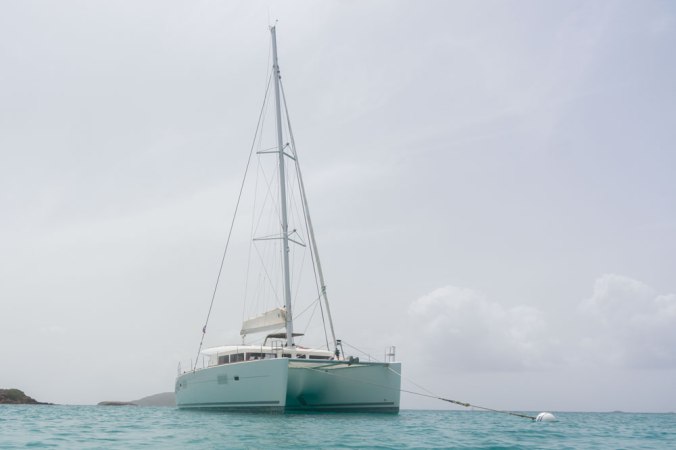
After the snorkeling, the swims, and the hike, we were all starving, so Mary cooked up some tacos for lunch, which were immediately devoured.

Then we did some more snorkeling around the boat with turtles. I also came across a little trunkfish.



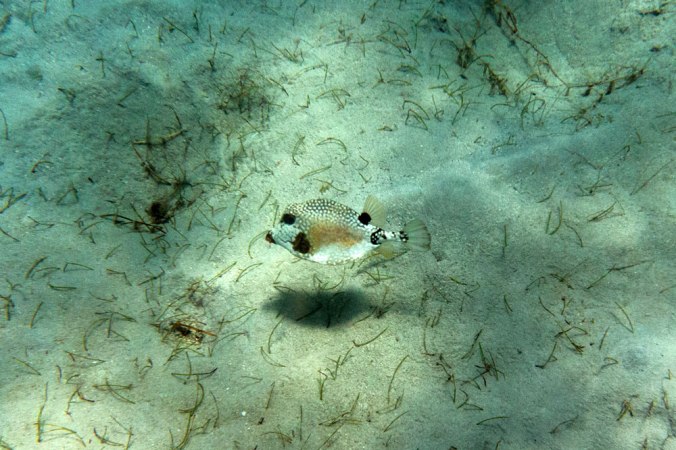
We’d heard one of the best places to find spiny lobster was the reef just around the corner from Tortuga Bay, so several of us loaded up in a dink to head there while another group decided to go hike a few more trails and to check out The Baths.
The reef on the northwest corner of Culebrita was truly fantastic.



Up to that point it was the best one I’d ever seen. There was also some old ship wreckage mixed in that had become part of the reef.

I was very curious as to whether or not there was still wine in that bottle.


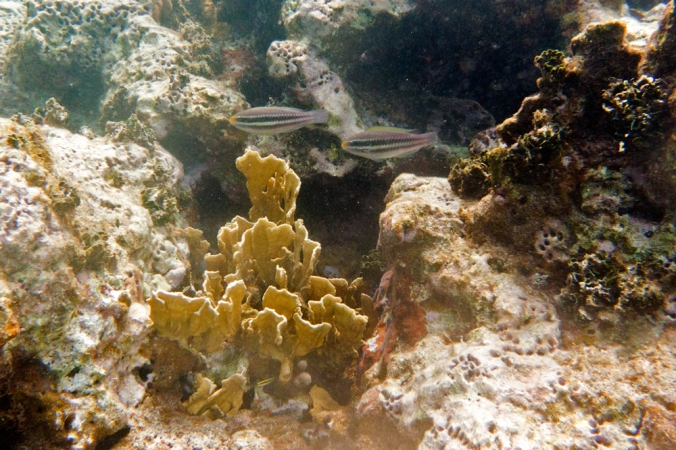

As we were oooohhing and awwwing at all the fish, a huge, gray C-130 flew low over Culebrita and circled three times before heading out into the Atlantic. We later learned that the Puerto Rican Air National Guard maintains an entire fleet of C-130s to patrol the area and rescue sinking ships.
After a bit more snorkeling, I finally stumbled across a spiny lobster.

It doesn’t really translate in the photo, but this lobster was huge. I would estimate the antennae to be three feet long (each, not combined), and it would have taken both of my hands to go around the lobster’s body.
Not a single one of us had ever actually grabbed a lobster before, so there was a lot of floating and staring at it before someone actually gave it a try. Nobody actually managed to grab it, which was probably good since it was as tall or taller than the bucket we had brought to put it in.
Defeated by the monster lobster and still needing to head back to Culebra before sunset, we decided to call it a day.
Meanwhile, Mary and Jayne were soaking in The Baths, which turned out to be pristine tidal pools on the other side of the island.
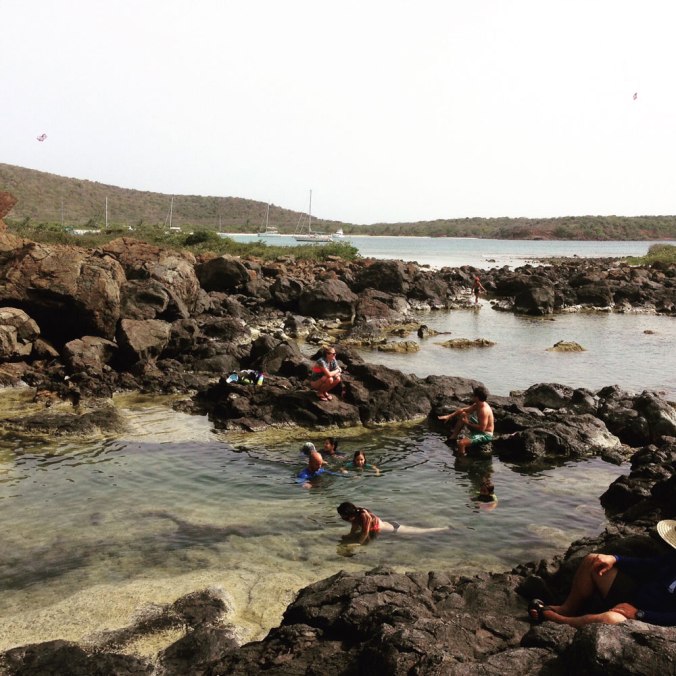
We all rendezvoused at the catamarans and headed out to find a mooring in Ensenada Honda, Culebra — billed as the best hurricane hole in the Caribbean.

As we neared the town of Dewey and civilization, we found the type of boats changed. We actually came across these two flamboyant houseboats in one mooring field.
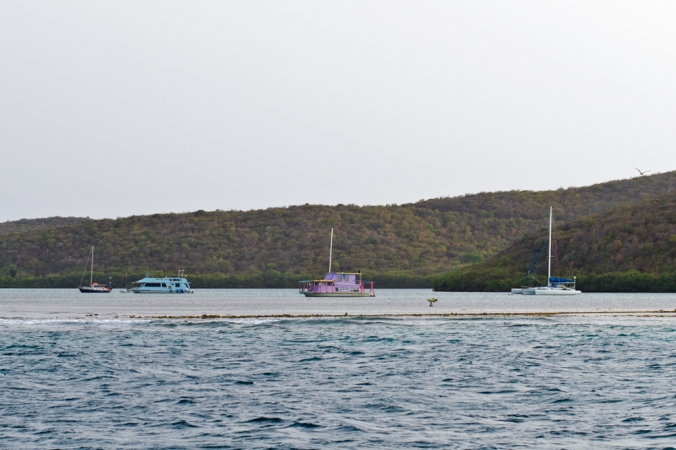
We also saw a homebuilt Piver trimaran, a small Gemini cat, and one 25′ sailboat that didn’t even have a mast moored right along all the hard core cruiser sailboats. It seemed living on the water was the cheap alternative in Culebra.

The mooring fields were full in Ensenada Honda, so motored inward towards the municipal building.

I’d like to say we were pros at anchoring by now, but as I was lowering the anchor using the remote control, it stuck. It just kept letting out chain. I vigorously tapped the remote with no result and finally pressed the “up” button, which promptly popped the breaker of the windlass.
Now we were stuck with the anchor half out and possibly dragging. I grabbed a winch handle and started trying to psych myself up for the job of having to crank in all that chain by hand while Andy went searching for the breaker box.
Thankfully Andy was able to reset the breaker, I let out some more chain, and we stopped dragging. Andy tried to dive the anchor to make sure it was ok, but the water was so dark we couldn’t see anything.

Meanwhile Batubara and Chateau du Mer had arrived and dropped anchor as well. The first wave of crew headed to town to buy more booze and to scout the restaurants. The wind had picked up and our crappy dinghy motor made getting out of the shallows and away from the dinghy dock a real fiasco, so there was quite a delay working that situation out and getting the stupid outboard running again before we could go pick up the rest of the crew. (When chartering, never settle for a crappy outboard.)

Once we were finally all ashore we took a nice walk through the streets of Dewey. While Esperanza had island dogs wandering the streets, Dewey had friendly cats that followed us for a bit before going back to lounging.

The outstanding night spot seemed to be the Dinghy Dock Restaurant.

They had tables dockside with lights under the water, illuminating the huge tarpon circling the area, waiting for someone to throw dinner scraps into the water. There was also a fishing bat that would occasionally swoop through and grab things out of the water. The food was great, and it was a really cool atmosphere.

By the time we finished dinner, I could barely hold my head up. It had been an incredibly fun, but an incredibly long day. We walked back to the dinghy, climbed aboard Caicu, and went straight to bed.
But here’s one more sea turtle picture from our afternoon at Culebrita just because sea turtles are awesome.










